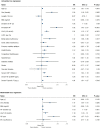Women Have More Recurrences of Atrial Fibrillation than Men after Thoracoscopic Ablation and Suffer More from Established Risk Factors
- PMID: 37048733
- PMCID: PMC10095488
- DOI: 10.3390/jcm12072650
Women Have More Recurrences of Atrial Fibrillation than Men after Thoracoscopic Ablation and Suffer More from Established Risk Factors
Abstract
Introduction: Atrial fibrillation (AF) is more prevalent in men than in women. However, women with AF are more symptomatic, have a worse quality of life, a higher stroke risk and may therefore benefit most from ablation. In this study we aim to identify the risk of recurrent AF after thoracoscopic ablation, and assess the differential impact of the risk factors for recurrence between women and men.
Method: This is a single center cohort study, including patients undergoing thoracoscopic ablation for advanced AF between 2008 and 2019. All patients were clinically followed up for two years with quarterly 24 h Holter monitoring and ECGs for the detection of recurrent AF. Left atrial appendage (LAA) tissue was collected for collagen analysis.
Results: We included 571 patients, of whom 143 (25%) were women. Women were older than men (63 ± 8.3 y vs. 59 ± 8.5, p < 0.001), but had fewer cardiovascular risk factors, myocardial infarctions (1.4% vs. 6.5%, p = 0.03) and, in particular, vascular disease (7.0% vs. 16.1%, p = 0.01). Women suffered more from AF recurrence, driven by more atrial tachycardias, and sex was an independent risk factor for recurrence (HR1.41 [1.04-1.91], p = 0.028]). The presence of vascular disease was associated with an increased risk for AF recurrence in women, but not in men. In LAA histology, women had more collagen than men, as had patients with persistent compared to paroxysmal AF.
Conclusion: Women had 15% more recurrences, driven by more atrial tachycardias, which may be explained by a more fibrotic atrial substrate. What's new? Women undergoing thoracoscopic AF ablation have a higher risk of recurrent AF, driven by more atrial tachycardias. Among patients with left atrial enlargement or persistent AF, women have worse outcomes than men. Vascular disease was a risk factor for recurrence in women, but not in men. In a histopathologic analysis of the left atrial appendage, women had more collagen than men, as had patients with persistent compared to paroxysmal AF.
Keywords: atrial fibrillation; risk factors; sex differences; thoracoscopic AF ablation.
Conflict of interest statement
A.H.G.: Consultant for Atricure, last 5 years no revenue, J.R. de Groot is supported by research grants through his institution from Abbot, Atricure, Bayer, Boston Scientific, Daiichi Sankyo, Johnson & Johnson and Medtronic, and received speaker fees/consulting fees from Atrian Medical, Atricure, Bayer, Biotronik, Daiichi Sankyo, IPPMed, Medtronic, Novartis and Servier. The other authors report no disclosures.
Figures






References
-
- Benjamin E.J., Muntner P., Alonso A., Bittencourt M.S., Callaway C.W., Carson A.P., Chamberlain A.M., Chang A.R., Cheng S., Das S.R., et al. Heart Disease and Stroke Statistics-2019 Update: A Report from the American Heart Association. Circulation. 2019;139:e56–e528. doi: 10.1161/CIR.0000000000000659. - DOI - PubMed
-
- Krijthe B.P., Kunst A., Benjamin E.J., Lip G.Y., Franco O.H., Hofman A., Witteman J.C., Stricker B.H., Heeringa J. Projections on the number of individuals with atrial fibrillation in the European Union, from 2000 to 2060. Eur. Heart J. 2013;34:2746–2751. doi: 10.1093/eurheartj/eht280. - DOI - PMC - PubMed
-
- Schnabel R.B., Yin X., Gona P., Larson M.G., Beiser A.S., McManus D.D., Newton-Cheh C., Lubitz S.A., Magnani J.W., Ellinor P.T., et al. 50 year trends in atrial fibrillation prevalence, incidence, risk factors, and mortality in the Framingham Heart Study: A cohort study. Lancet. 2015;386:154–162. doi: 10.1016/S0140-6736(14)61774-8. - DOI - PMC - PubMed
-
- Magnussen C., Niiranen T.J., Ojeda F.M., Gianfagna F., Blankenberg S., Njolstad I., Vartiainen E., Sans S., Pasterkamp G., Hughes M., et al. Sex Differences and Similarities in Atrial Fibrillation Epidemiology, Risk Factors, and Mortality in Community Cohorts: Results from the BiomarCaRE Consortium (Biomarker for Cardiovascular Risk Assessment in Europe) Circulation. 2017;136:1588–1597. doi: 10.1161/CIRCULATIONAHA.117.028981. - DOI - PMC - PubMed
-
- Zylla M.M., Brachmann J., Lewalter T., Hoffmann E., Kuck K.H., Andresen D., Willems S., Eckardt L., Tebbenjohanns J., Spitzer S.G., et al. Sex-related outcome of atrial fibrillation ablation: Insights from the German Ablation Registry. Heart Rhythm. 2016;13:1837–1844. doi: 10.1016/j.hrthm.2016.06.005. - DOI - PubMed
LinkOut - more resources
Full Text Sources

